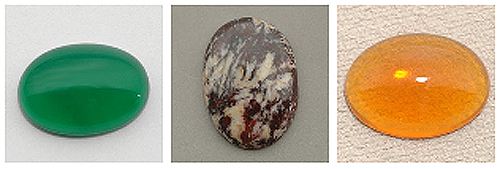

These lighter-color crystals that are here, they actually are colored by chromium but some people might want to say that it's green beryl because it's not a rich enough color to be categorized as emerald. It would generally be a lighter color and no chromium present in the gem would pretty much categorize it as green beryl. One question I get is, "When is an emerald green beryl?" I think technically green beryl is a gem that's not colored by chromium, which the coloring agent for emerald is chromium. So Ethiopia is a new source and promises to be one of the most exciting new gem find probably in this decade. I've had gems from Madagascar that aren't treated, but this is one of the few in my entire time in business that is completely untreated, and it does increase the value by 40% to 50% over a treated stone. GIA has certified it as a non-treated stone, so no filling with oils, which this is probably the first gem in my entire. Not only does it have beautiful color and appears to be eye clean, this stone has received no treatments. I bought a stone at Tucson this year and cut it, it's this gem right here. The newest source, just in the last year, late 2016, was found in Ethiopia. I don't think it's ever gonna be a commercially viable source, but they do produce emeralds here in the United States. Come to find out he pulled out an article from Gems and Gemology of the recent discovery of the material, and I found many, many fine emeralds at that source.Īnother new source is in North Carolina. But the quality of the emerald there was just amazing and I had to go a local gemologist just to make sure that this stuff was real. I didn't even know that it existed there at the time. Then my first tip to Madagascar, I was kind of shocked to see emerald there. Zambia produced a huge quantity of material of very deep color, often strongly to the blue, but just very beautiful stones. About that time we also found emerald in Africa. But for probably in the '80s or '90s, it was one of the major producers of emerald in the world. Lot of issues with clarity, but that's typical of emeralds. Both those mines produced a large quantity of material and were really the only game for quite some time.Īfter that, we found material in Brazil. Chivor was generally a lighter color tending towards slightly blue, whereas Muzo was slightly yellow in color. Two mines were the primary producers, Muzo mine, Chivor, with the Muzo mine being the finest and biggest stones, deeper color. Columbia, by far, produced some of the biggest and finest emeralds ever to come out of the ground. The source there produced emerald, but not a very good quality emerald. Emerald started back in Cleopatra's time.

So the next gem in the beryl family is the most famous and most valued, which is emerald. Otherwise, if you have a natural crystal, you get those long emerald cuts. That's what gives you the unusual shapes. This pear shape that you see in this video, this was cut from a broken piece of aqua. Occasionally you'll have a minor inclusion in them, but we try to cut very high clarity stones. The clarity of aqua, we have high expectations for clarity. They can often be long pencil shapes, as you see in some of the pendants we have. Because of the shape of the natural crystal, we tend to cut emerald cuts. So you do get very large crystals of aquamarines. But mostly aqua, to get to the straight blue color, is heated.Īs you can see from the crystals we have on display, these crystals from Madagascar were quite large, maybe six inches long. Occasionally you'll get aquas that have a little bit of green that are very attractive, and we don't heat those. Aqua is colored by iron and also has the yellow color, the ferric part of the coloring agent, and that's what we're trying to remove. In heating, you get rid of the ferric iron that's in aquamarine. Aqua is generally heated to remove the yellow color. And the yellow color that causes it to be green. All aqua tends to have a little bit of gray to it, the more gray, the less the value. The depth of color determines the price, but there are also secondary colors that can affect the value of a stone. In general, the value of aquamarine is based on how deep the color is. The aquamarines, these are from Madagascar, these from Nigeria. The beryls generally form in these long, hexagonal crystals, as you'll see here in these bigger crystals. They have good hardness, so a very wearable stone, and for us as cutters it's an easy stone to cut and polish. Aqua and all the beryls are good, tough stones. I'm gonna start out with aquamarine, the blue form of beryl. The beryls include aquamarine, heliodor, emerald, morganite, and the red beryl bixbite.

I'm here today to talk to you about beryls. Hi, I'm Steve Moriarty from Moriarty's Gem Art in Crown Point, Indiana.


 0 kommentar(er)
0 kommentar(er)
